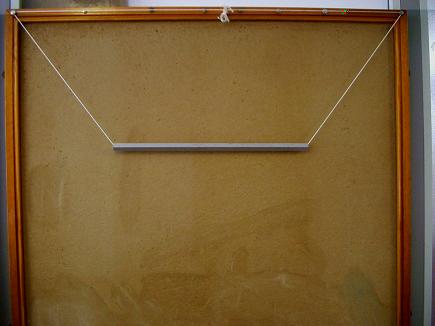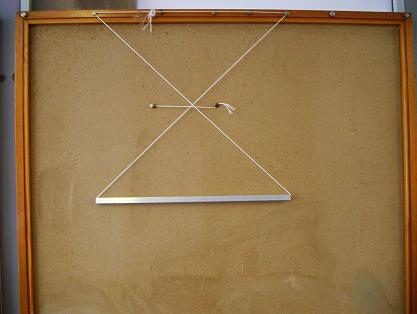Natural frequency of suspended systems
This model demonstration verifies Eq. 14-8 and shows the unstable equilibrium state at which the suspended system will not oscillate.


a) Vertical suspension system b) Outward inclined suspension system


c) Inward inclined suspension system d) Unstable equilibrium state
Fig. 14-4: Typical forms of a suspension system used for demonstration and tests
A suspended system consists of a uniform hollow aluminium bar with a square section (a rigid body) and two symmetric strings to suspend the bar. The bar has a length of b =0.45m, total mass of M = 0.094 kg and moment of inertia about its centroid of ![]() . The length and the angles of the strings can be varied.
. The length and the angles of the strings can be varied.
Three typical suspension forms include vertical (Fig. 14-4a, ![]() ), outward inclined (Fig. 14-4b,
), outward inclined (Fig. 14-4b, ![]() ) and inward inclined (Fig. 14-4c,
) and inward inclined (Fig. 14-4c, ![]() ) suspension systems. In the tests, an initial lateral displacement is applied to the bar and the bar is suddenly released to generate free vibrations. The number of oscillations is counted and a stopwatch is used to record the duration of the vibrations. The swaying natural frequencies of seven different forms of suspension were measured and are listed in Table 14-2 together with the theoretical predictions obtained using Eq. 14-8. It can be seen that there is good agreement between the measured and calculated lateral natural frequencies.
) suspension systems. In the tests, an initial lateral displacement is applied to the bar and the bar is suddenly released to generate free vibrations. The number of oscillations is counted and a stopwatch is used to record the duration of the vibrations. The swaying natural frequencies of seven different forms of suspension were measured and are listed in Table 14-2 together with the theoretical predictions obtained using Eq. 14-8. It can be seen that there is good agreement between the measured and calculated lateral natural frequencies.
Figure 14-4d shows an unstable equilibrium state of the system where the two strings cross each other. An additional horizontal string is applied to prevent out-plane movement of the system. When a small movement is applied to the system, the aluminium bar moves to, and balances at, a new position without oscillation.
Table 14-2: Comparison of the measured and predicted lateral natural frequencies
Parameters |
Experiment |
Theory |
error |
q =0 o , l =0.415m |
0.778Hz |
0.774Hz |
-0.5% |
q =-10.15 o , l =0.431m |
0.773Hz |
0.769Hz |
-0.5% |
q =-22.28 o , l =0.825m |
0.543Hz |
0.536Hz |
-1.3% |
q =-30.69 o , l =0.485m |
0.718Hz |
0.717Hz |
-0.1% |
q =-52.7 o , l =0.584m |
UES |
UES |
- |
q =24.66 o , l =0.405m |
0.930Hz |
0.929Hz |
-0.1% |
q =48.4 o , l =0.324m |
1.67Hz |
1.71Hz |
2.4% |
UES--Unstable equilibrium state.
